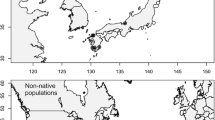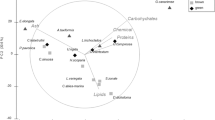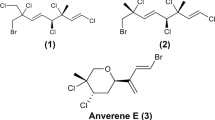Abstract
Within-plant variation in the concentration of secondary metabolites, nutritive value, toughness, and susceptibility to herbivory was assessed for the brown alga Dictyota ciliolata. When young apices and older tissue from the same plant were offered in equal abundance to the herbivorous amphipod Ampithoe longimana and the sea urchin Arbacia punctulata, young apices were consumed about 2 times more than older tissue. Compared to young apices, the less preferred older tissue had a less palatable lipophilic extract, significantly higher concentrations of two secondary metabolites (another secondary metabolite did not differ significantly), 33% more soluble protein, and was 233% tougher. Higher levels of chemical defenses in older tissues, and not tissue toughness or nutritive value, appear to be responsible for the preference of Ampithoe longimana for young apices. The pattern of lower levels of chemical defenses in young than older tissues of D. ciliolata is the opposite of the pattern observed in coenocytic seaweeds and most vascular terrestrial and marine plants, all of which have translocation systems for moving materials among plant portions. Unlike these other plants, which preferentially allocate chemical defenses to young tissues, D. ciliolata cannot readily translocate secondary metabolites. The growth-differentiation balance hypothesis suggests that actively dividing and expanding cells are less able to produce secondary metabolites. This hypothesis may help explain why older tissues are better defended than young, rapidly growing apices.
Similar content being viewed by others
References
Bold HC, Wynne MJ (1985) Introduction to the algae: structure and reproduction, 2 edn. Prentice-Hall, NJ
Bradford MM (1976) A rapid and sensitive method for the quantification of microgram quantities of protein utilizing the principle of protein-dye binding. Anal Biochem 72: 248–254
Carlson DJ, Lubchenco J, Sparrow MA, Trowbridge CD (1989) Fine-scale variability of lanosol and its disulfate ester in the temperate red alga Neorhodomela larix. J Chem Ecol 15: 1321–1333
Coley PD, Aide TM (1991) Comparison of herbivory and plant defenses in temperate and tropical broad-leaved forests. In: Price PW, Lewinsohn TM, Fernandes GW, Benson WW (eds) Plant-animal interactions: evolutionary ecology in tropical and temperate regions. Wiley, New York, pp 25–49
Cronin G, Hay ME (1996) Seaweed susceptibility to herbivores depends on recent history of both the plant and animal. Ecology (in press)
Cronin G, Lindquist N, Hay ME, Fenical W (1995) Effects of storage and extraction procedures on yields of lipophilic metabolites from the brown seaweeds Dictyota ciliolata and Dictyota menstrualis. Mar Ecol Prog Ser 119: 265–273
Davis EM (1988) Protein assays: a review of common techniques. Am Biotechnol Lab 6: 28–37
Denno RF, McClure MS (1983) Variable plants and herbivores in natural and managed systems. Academic Press, New York
Duffy JE, Hay ME (1991) Food and shelter as determinants of food choice by an herbivorous marine amphipod. Ecology 72: 1286–1298
Duffy JE, Hay ME (1994) Herbivore resistance to seaweed chemical defense: the roles of mobility and predator risk. Ecology 75: 1304–1319
Dussourd DE, McClure RF (1991) Deactivation of plant defense: correspondence between insect behavior and secretory canal architecture. Ecology 72: 1383–1396
Fagerström T, (1989) Anti-herbivore chemical defense in plants: a note on the concept of cost. Am Nat 133: 281–287
Feeny P (1970) Seasonal changes in oak leaf tannins and nutrients as a cause of spring feeding by winter moth caterpillars. Ecology 51: 565–581
Feeny P (1976) Plant apparency and chemical defense. Recent Adv Phytochem 10: 1–40
Gulmon SL, Mooney HA (1986) Costs of defenses and their effects on plant productivity. In: Givnish TJ (ed.) On the economy of plant form and function. Cambridge University Press, Cambridge, UK, pp 681–698
Hay ME (1984) Predictable spatial escapes from herbivory: how do these affect the evolution of herbivore resistance in tropical marine communites? Oecologia 64: 396–407
Hay ME (1991) Fish-seaweed interactions on coral reefs: effects of herbivorous fishes and adaptations of their prey. In: Sale PF (ed.) The ecology of fishes on coral reefs. Academic Press, San Diego, pp 96–119
Hay ME (1992) The role of seaweed chemical defenses in the evolution of feeding specialization and in the mediation of complex interactions. In: Paul VJ (ed.) Ecological roles of marine natural products. Cornell University Press, Ithaca, NY pp 93–118
Hay ME, Fenical W (1988) Marine plant-herbivore interactions: the ecology of chemical defense. Annu Rev Ecol Syst 19: 111–145
Hay ME, Steinberg PD (1992) The chemical ecology of plantherbivore interactions in marine versus terrestrial communities. In: Rosenthal GA, MR Berenbaum (eds.) Herbivores: their interactions with secondary plant metabolites. II. Evolutionary and ecological processes. Academic Press, New York, pp 371–413
Hay ME, Duffy JE, Pfister CA, Fenical W (1987) Chemical defense against different marine herbivores: are amphipods insect equivalents? Ecology 68: 1567–1580
Hay ME, Paul VJ, Lewis SM, Gustafson K, Tucker J, Trindell RN (1988a) Can tropical seaweeds reduced herbivory by growing at night? Diel patterns of growth, nitrogen content, herbivory, and chemical versus morphological defenses. Oecologia 75: 233–245
Hay ME, Renaud PE, Fenical W (1988b) Large mobile versus small sedentary herbivores and their resistance to seaweed chemical defenses. Oecologia 75: 246–252
Hay ME, Duffy JE, Fenical W (1990) Host-plant specialization decreases predation on a marine amphipod: an herbivore in plant's clothing. Ecology 71: 733–743
Hay ME, Kappel QE, Fenical W (1994) Synergisms in plant defense against herbivores: interactions of chemistry, calcification, and plant quality. Ecology 75: 1714–1726
Herms DA, Mattson WJ (1992) The dilemma of plants: to grow or defend. Q Rev Biol 67: 283–335
Littler MM, Littler DS (1980) The evolution of thallus form and survival strategies in benthic marine macroalgae: field and laboratory tests of a functional form model. Am Nat 116: 25–44
Lubchenco J, Gainess SD (1981) A unified approach to marine plantherbivore interactions. I. Populations and communities. Annu Rev Ecol Syst 12: 405–437
Mattson WJ (1980) Herbivory in relation to plant nitrogen. Annu Rev Ecol Syst 11: 119–161
McKey D (1974) Adaptive patterns in alkaloid physiology. Am Nat 108: 305–320
McKey D (1979) The distribution of secondary compounds within plants. In: Rosenthal GA, Janzen DH (eds) Herbivores: their interactions with secondary plant metabolites. Academic Press, New York, pp 55–133
Mooney HA, Gulmon SL (1982) Constraints of leaf structure and function in reference to herbivory. BioScience 32: 198–206
Orians GH, Janzen DH (1974) Why are embryos so tasty? Am Nat 108: 581–592
Paul VJ (1992) Ecological roles of marine natural products. Cornell University Press, Ithaca, NY
Paul VJ, Van Alstyne KL (1988) Chemical defense and chemical variation in some tropical. Pacific species of Halimeda (Halimedaceae; Chlorophyta). Coral Reefs 6: 263–269
Peterson CH, Renaud PE (1989) Analysis of feeding preference experiments. Oecologia 80:82–86
Phillips DW, Towers GHN (1982) Chemical ecology of red algal bromophenols. I. Temporal, interpopulational, and withinthallus measurements of lanosol levels in Rhodomela larix (Turner) C. Agardh J Exp Mar Biol Ecol 58: 285–293
Poore AGB (1994) Selective herbivory by amphipods inhabiting the brown alga Zonaria angustata. Mar Ecol Prog Ser 107: 113–123
Raupp MJ, Denno RF (1983) Leaf age as a predictor of herbivore distribution and abundance. In: Denno RF, McClure MS (eds.) Variable plants and herbivores in natural and managed systems. Academic Press, New York, pp 91–124
Rhoades DF (1979) Evolution of plant chemical defense against herbivores. In: Rosenthal GA, Janzen DH (eds.) Herbivores: their interactions with secondary plant metabolites. Academic Press, New York, pp 3–54
Rhoades DF, Cates RG (1976) Toward a general theory of plant antiherbivore chemistry. Recent Adv Phytochem 10: 168–213
Rice WR, Gaines SD (1994) ‘Heads I win, tails you lose’: testing directional alternative hypotheses in ecological and evolutionary research. Trends Evol Ecol 9: 235–237
Schmitz K (1981) Translocation. In: Lobban CS, Wynne MJ (eds.) Botanical Monographs, vol 17. The biology of seaweeds. Blackwell, London, pp 534–558
Steinberg PD (1984) Algal chemical defense against herbivores: allocation of phenolic compounds in the kelp Alaria marginata. Science 223: 405–407
Tugwell S, Branch GM (1989) Differential polyphenolic distribution among tissues in the kelps Ecklonia maxima, Laminaria pallida, and Macrocystis angustifolia in relation to plant defense theory. J Exp Mar Biol Ecol 129: 219–230
Tuomi J (1992) Toward integration of plant defence theories. Trends Evol Ecol 7: 365–367
Van Alstyne KL (1989) Adventitious branching as a herbivoreinduced defense in the intertidal brown alga Fucus distichus. Mar Ecol Prog Ser 56: 169–176
Young DN, Howard BM, Fenical W (1980) Subcellular localization of brominated secondary metabolites in the red alga Laurencia snyderae. J Phycol 16: 182–185
Author information
Authors and Affiliations
Corresponding author
Rights and permissions
About this article
Cite this article
Cronin, G., Hay, M.E. Within-plant variation in seaweed palatability and chemical defenses: optimal defense theory versus the growth-differentiation balance hypothesis. Oecologia 105, 361–368 (1996). https://doi.org/10.1007/BF00328739
Received:
Accepted:
Issue Date:
DOI: https://doi.org/10.1007/BF00328739




